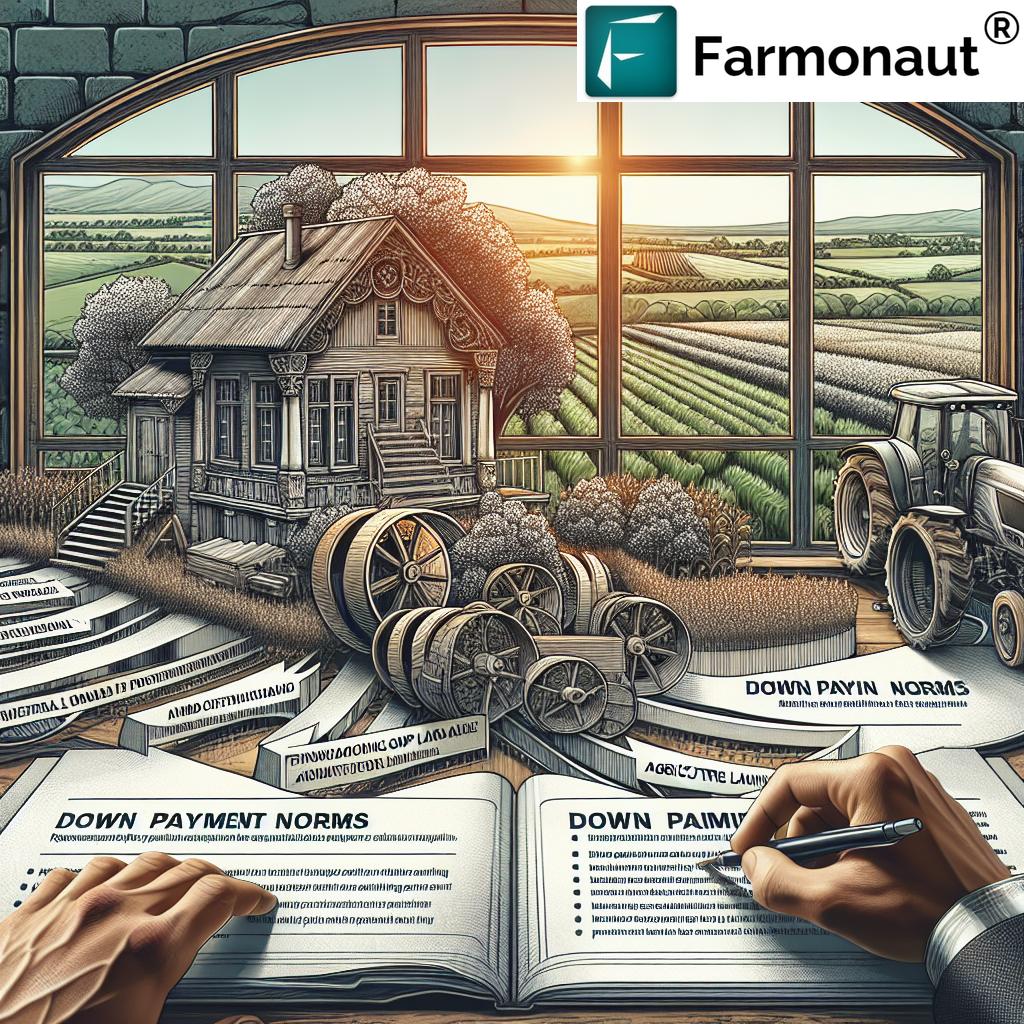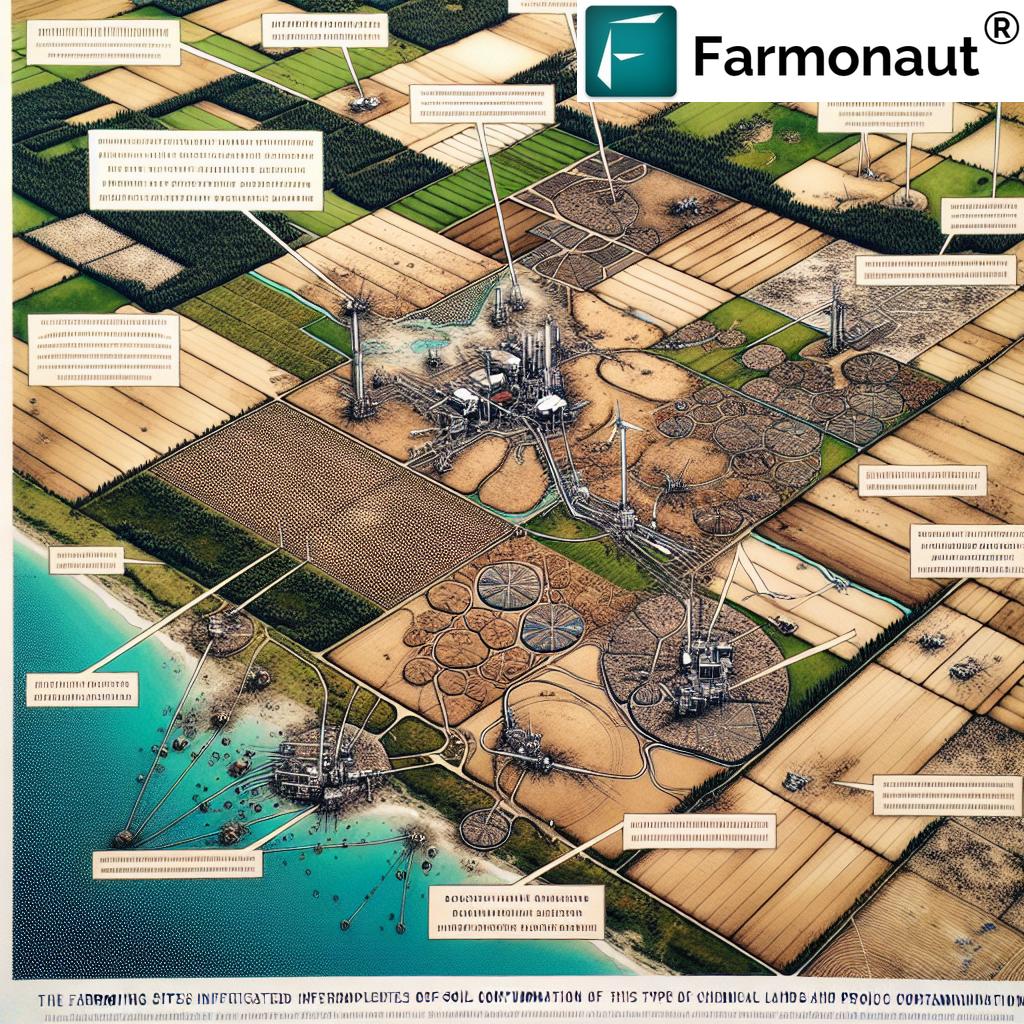Farm Land Loans Texas: 7 Top Financing Options
- Summary: Farm Land Loans in Texas
- Why Consider a Texas Farm Land Loan?
- Types of Farm Land Loans Texas
- Comparison Table: Texas Farm Land Loan Options and Rates
- Eligibility Criteria for Farm Land Loans in Texas
- How to Apply for Land Loans in Texas
- Key Factors When Financing Texas Agriculture Property
- Refinancing Farm Land Loans Texas
- How Farmonaut Technology Supports Texas Landowners & Lenders
- FAQ: Texas Farm Land Loans
- Additional Resources
- Conclusion
Farm Land Loans in Texas: A Comprehensive Guide
Acquiring farm land in Texas represents a significant investment and a crucial step for farmers, ranchers, and agribusinesses aiming to expand or start agricultural operations. Understanding the variety of agricultural financing options available, as well as the eligibility criteria, application steps, and key considerations will empower you to make informed decisions and improve your success rate when applying for a Texas farm land loan.
This guide features a detailed comparison of the top farm land loans Texas offers, step-by-step instructions on how to apply for land loans in Texas, and practical information to help you evaluate loan rates, terms, payment requirements, and lender types.
Why Consider a Texas Farm Land Loan?
- Expansion of Operations: Purchasing additional land allows for increased productivity and diversification in crops or livestock.
- Investment Potential: Texas land values have shown strong long-term growth, making farmland a valuable asset in your financial portfolio.
- Support for New Farmers: Specialized programs help beginning and underserved farmers gain access to land and resources.
- Accessible Loan Programs: Various lenders, from banks to government-backed programs, provide tailored Texas agricultural property financing.
- Flexible Options: Loan options exist for both raw and improved land, as well as refinancing and improvement of existing property.
Types of Farm Land Loans Texas
When it comes to Texas agricultural property financing, multiple loan types are available to suit the needs of both new and experienced farmers:
-
Conventional Land Loans
- Available via banks, credit unions, and private lenders.
- Great for both raw land and improved agricultural property.
- Rates and terms depend on credit score, payment capacity, and property location.
-
Farm Credit System Loans
- Specialized institutions like Capital Farm Credit provide tailored options for farmers, ranchers, and agribusinesses.
- Flexible terms and competitive Texas land loan rates.
- Support for operating costs, equipment, and improvements, not just land purchases.
-
Farm Service Agency (FSA) Loans
- USDA-backed, designed for family-sized farmers and ranchers who can’t obtain commercial credit.
- Covers ownership, operating, and improvement loans.
- Lenient eligibility for beginning farmers and minorities.
-
Veterans Land Board (VLB) Loans
- Exclusively for Texas veterans and military members.
- Low minimum payment (5%) and up to $150,000 in financing.
- Terms tailored to service members’ needs.
-
Commercial Agribusiness Loans
- Offered by larger banks and finance companies for larger operations and agribusinesses.
- May include operating lines of credit, equipment loans, and farm expansion funds.
-
Ag Co-op & Credit Union Loans
- Regional and local agricultural cooperatives and community credit unions often offer attractive farmland loans.
- Member-focused and sometimes offer lower rates or more flexible qualification criteria.
-
Seller Financing & Private Loans
- Useful for those who may not qualify for traditional financing.
- Rates and terms often vary—careful review is required.
Comparison Table: Texas Farm Land Loan Options and Rates
| Lender/Institution | Loan Type | Estimated Interest Rates (Annual %) |
Min/Max Loan Amount | Down Payment Requirement | Eligibility Criteria | Key Features | Application Process Steps |
|---|---|---|---|---|---|---|---|
| Farm Credit System (e.g., Capital Farm Credit) | Ag Real Estate, Land, & Operating Loans | 6.0%–8.0% (varies based on product) | $25,000 – No Set Maximum | 20%–25% (can be higher for raw land) | Active or aspiring farmers, ranchers, agribusiness firms, recreational landowners | Specialized in ag lending, flexible terms, tailored to producer needs | Prequalification → Submit documents & land plan → Underwriting/approval → Closing |
| FSA (USDA) | Direct & Guaranteed Farm Ownership/Operating | 3.5%–5.0% (direct) Market-competitive (guaranteed) |
$50,000–$600,000 (ownership) |
0%–5% (program specific; some loans require no down payment) | Family-size or beginning farmers unable to obtain commercial credit, creditworthy | Low rates, flexible for new/underserved farmers, technical support available | Determine eligibility → Gather required docs → Apply via local FSA office → Review → Funding/closing |
| Veterans Land Board (VLB) | Land Loan for Veterans & Military | 6.95%–7.75% (as published)| | Up to $150,000 (min. 1 acre) | 5% minimum; fixed | Texas veteran/active military member, 90 days active duty, honorably discharged | Low down payment, long-term fixed rates, exclusive to veterans | Prequalify online → Submit application & military docs → Land evaluation → Approval & closing |
| Commercial Banks (e.g., Herring Bank) | Conventional Land/Ag Loans | 7.0%–10.0% (may vary by risk profile & land type) | $50,000–Multi-Million | 20%–50% (raw land often 30%+) | Good credit score, income verification, clear land use plan, typically not beginner-friendly | Fast decisions, multiple terms, access to related business lending | Inquiry → Prequalify → Submit docs/financials → Appraisal → Decision/funding/closing |
| Agri Credit Unions/Ag Co-ops | Member Agriculture & Land Loans | 6.0%–8.5% (co-op/member rates) | $10,000–$5,000,000+ (co-op policy dependent) | 15%–30% | Membership required, ties to local ag community | Competitive rates, local underwriting, community focus, flexible repayment | Join credit union/co-op → Meet with loan officer → Submit app → Credit & land check → Closing |
| Seller Financing / Private Lenders | Land & Farm Loans (Custom Terms) | 8.0%–12.0% (varies widely) | Flexible | 10%-25% or as negotiated | Negotiate directly, may have easier qualification but higher rates | May waive traditional credit score, flexible but higher risk and rates | Negotiate terms → Submit docs → Agreement/contract → Funding |
| Online Lenders / Specialty Financiers | Land Loans, Lines of Credit | 7.5%–12.0% (risk-based) | $20,000–$1,000,000+ | 15%-30% | Fast digital application, flexible or alternative credit review | Quick process, higher rates for low credit, less paperwork | Online prequalification → Upload docs & land info → Instant underwriting → E-sign & fund |
Eligibility Criteria for Farm Land Loans in Texas
- Conventional Loans:
- Generally require a minimum 20% down payment; may reach 30-50% for raw or unimproved land.
- Strong credit scores (typically 660+); higher for the most favorable rates.
- Stable income, debt-to-income ratio review.
- Clear intended use and development plan for the land.
- Farm Credit System Loans:
- Applicants must be engaged in agriculture or demonstrate intent for agricultural use.
- Supporting documents for a viable operation and evidence of farm management skills.
- Payment capacity and asset evaluation.
- FSA Loans:
- Family-size producer.
- Ineligible for sufficient commercial credit (must “fail” commercial eligibility test).
- Meet specific income and creditworthiness criteria (even if credit is limited).
- Active land management, US citizenship or legal residency.
- VLB Loans for Veterans:
- Veteran or military member with at least 90 days of active duty (honorably discharged).
- Proof of Texas residence; valid documentation.
- Property must be within the state and at least one acre.
- Ag Credit Unions/Co-ops:
- Membership required, often must live/work in coverage zone or be connected to the local agricultural community.
In each case, eligibility may depend on land use intent, credit history, payment ability, and, for government programs, additional program-specific requirements. Be sure to consult with each lender for the most up-to-date farm loan eligibility requirements.
How to Apply for Land Loans in Texas
The land loan application process in Texas typically involves several clear steps. Preparation, organization, and proactive communication can expedite your application and improve approval odds.
Step-by-Step Land Loan Application Process
-
Preparation
- Compile financial documentation: recent tax returns, pay stubs, bank statements, proof of assets/liabilities, and business plans if applicable.
- Gather property docs: title/deed info, survey, soil/suitability data, and intended use plan (e.g., crop, ranch, development, or recreation).
-
Prequalification
- Contact prospective lenders to discuss your goals and get prequalified.
- Review estimated loan terms, payment, and maximum amounts.
-
Property Selection
- Shop for suitable land meeting lender’s requirements (e.g., minimum acreage, land quality, location/zoning).
- Ensure the property matches your operational or investment needs.
-
Formal Application Submission
- Submit your formal application with all required documentation to your chosen lender (digital or in-branch).
- Complete any interviews or supplementary questionnaires as required.
-
Approval & Underwriting
- Lenders conduct credit checks, property appraisal, and review your farm plan/business projections.
- Additional information or clarification may be requested.
-
Closing
- Upon approval, review the final loan documents.
- Submit your required down payment (as low as 5% for some programs, up to 50% for raw land).
- Sign and notarize all legal documents.
- Title transfer and fund disbursement complete the process.
Tip: Early engagement with lenders, clear documentation, and a well-developed operational plan are key to a smooth application process.
Key Factors When Financing Texas Agriculture Property
-
Down Payment for Land Loans in Texas:
Typical payment is at least 20–25% but may be as low as 5% for certain veterans and FSA programs. Raw, unimproved, or lower-value rural land usually requires a larger down payment (up to 50%). -
Texas Land Loan Rates and Terms:
- Interest rates fluctuate with market conditions, your credit profile, property type, and lender policies.
- Fixed-rate loans provide stable payments, while adjustable-rate loans may initially be lower but can increase.
- Loan terms can range from 5 to 30 years depending on loan type, land use, and lender requirements.
-
Creditworthiness:
Lenders will assess your credit scores, financial history, repayment ability, and asset/debt situation.
Maintaining a strong financial profile can enhance your loan options and reduce your cost of borrowing. -
Land Use Plans:
Document your intended use for the land with clear, actionable plans. Most lenders require a solid plan for agricultural production, livestock, improvements, or recreational development. -
Land Improvements & Development:
Some loan programs allow financing for land improvements (e.g., fencing, irrigation, clearing, access roads). Be clear about your development strategy and include budgeting for improvements.
Explore: Farmonaut Large Scale Farm Management Tools for planning and monitoring large-acreage operations efficiently. -
Documentation Requirements:
- Proof of identity and legal residency (or military status for VLB loans).
- Accurate financial records, tax returns, and credit reports.
- Land surveys, soil reports, and photographs may also be needed.
Remember: Each lender’s requirements and application processes may vary—always verify the current details directly with the provider.
Supply Chain Transparency Tip: If you plan to use your land for commercial agriculture or sell to major distributors, consider Farmonaut Blockchain-Based Product Traceability for secure and transparent farm-to-market operations.
Looking to reduce your farm’s carbon footprint? Farmonaut Carbon Footprinting provides real-time tracking of farm emissions and resource usage, supporting both sustainability goals and compliance for Texas landowners.
Refinancing Farm Land Loans Texas
Refinancing is popular among Texas landowners seeking to adjust their loan terms, access better rates, consolidate debt, or unlock equity for operational improvements. Most lenders, including Texas Farm Credit, offer options to refinance existing land loans.
-
Reasons to Refinance Farm Land Loans
- Lock in a lower interest rate
- Switch from variable to fixed-rate terms for stability
- Access equity built up in the property for improvements or expansion
- Adjust monthly payment amounts by changing loan tenure
- Consolidate multiple loans for better management
-
Refinancing Process Overview
- Assess current loan balance, rate, and desired new structure
- Shop and compare offers from Texas lenders specializing in agricultural refinancing
- Submit updated application, asset documents, and farm plans as necessary
- Complete appraisal and underwriting steps
- On approval, complete closing to retire existing loan and activate new terms
Note: Refinancing may involve fees or prepayment penalties—always review the total cost before proceeding.
Farmers seeking crop loan and insurance support? Explore Farmonaut’s crop loan and insurance verification solutions for streamlined approvals and fraud-resistant digital documentation for financial institutions.
How Farmonaut Technology Supports Texas Landowners & Lenders
At Farmonaut, we understand the modern needs of Texas landowners, farmers, agribusinesses, and lenders. Our advanced agricultural technology solutions, delivered through satellite imagery, AI, and blockchain, help optimize your land investment and support a smooth loan process. Here’s how our technology benefits your farm or ranch in the context of land loans and agricultural property management:
- Satellite-Based Crop Health Monitoring: Our platform uses multispectral satellite imagery to assess vegetation health (NDVI), soil moisture, and other vital indicators. This enhances your ability to present accurate, data-driven farm plans to lenders during the loan application process.
- AI-Based Advisory Systems: Jeevn AI gives real-time, site-specific guidance on crop selection, irrigation, and resource allocation—empowering borrowers to demonstrate scalable operational plans.
- Blockchain-Based Traceability: Transparent tracking ensures your products meet rigorous supply chain standards. Verification from seeding to sale reinforces the credibility of your land use proposal.
-
Resource & Fleet Management: Our tools assist in mapping, planning, and monitoring activities over large Texas acreages, making it easier to justify improvement loans or support refinancing efforts.
See: Farmonaut’s Fleet Management tools for optimizing equipment use and reducing overhead. -
Carbon Footprint Tracking: Real-time data on emissions makes it simple to align your operation with increasingly stringent lender and governmental sustainability requirements.
Learn more about carbon monitoring services.
Our services are accessible through web, Android, iOS App, and API/API-Developer-Docs for integration into your agribusiness workflows:
-
Farmonaut Satellite API
Integrate real-time satellite and weather data into your financial assessments, reporting, and farm management dashboards.
API Docs: Farmonaut API Developer Docs
FAQ: Texas Farm Land Loans
What is the minimum down payment for land loans in Texas?
The minimum down payment can vary from 5% for Veterans Land Board loans or select FSA programs to as much as 50% for conventional raw land loans. Government-backed programs often require less upfront payment, while private/commercial lenders may require more.
How do Texas land loan rates compare between lenders?
Texas land loan rates generally range from 6%–10%, depending on loan type, borrower creditworthiness, property use, and term. Ag credit unions and Farm Credit System lenders frequently offer more competitive rates for agricultural purposes compared to general banks or alternative financiers.
Which types of agricultural loans are available to new farmers in Texas?
Options include FSA Direct Farm Ownership loans, USDA Beginning Farmer programs, member-focused cooperative loans, and certain conventional mortgage products with strong business plans. Always examine eligibility and match your needs to the right lender.
Can I refinance an existing land loan?
Yes, most conventional and agricultural lenders in Texas offer refinancing options. This is often used to secure a lower interest rate, change terms, or access equity for further improvements.
What documents are needed to apply for a farm land loan?
You’ll typically require: proof of identity and residency, detailed financial statements, recent tax documents, property information, and a clear intended use plan or business case for the land. Specialized programs (FSA, VLB) may request specific forms of military or agricultural documentation.
Are there loan programs exclusively for veterans in Texas?
The Texas Veterans Land Board (VLB) offers exclusive land loan programs, including low down payments and long-term fixed rates for Texas veterans and qualifying military members.
How can Farmonaut help with my land loan application process?
Our technology makes it easier to generate real-time, satellite-based evidence of agricultural activity, land use potential, and operational planning. This transparency can enhance your application’s credibility and support discussions with lenders or insurers.
What if my credit score is not ideal?
Consider FSA direct loans or look into credit unions and cooperatives that may be more flexible than commercial banks. If denied, work on improving your credit score by reducing debt, making timely payments, and strengthening your farm’s financial statements.
Additional Resources for Farm Land Loans Texas
- Capital Farm Credit – Farm Credit System’s Texas branch, specializing in ag loans.
- FSA Texas – USDA Farm Service Agency; for all FSA-backed programs and applications.
- Texas General Land Office – Details on Veterans Land Board loans and more.
- Texas Farm Credit – For refinancing and new land loan options.
- Herring Bank – Understanding Texas land loans and current market rates.
- Texas A&M AgriLife Extension Service – Local support, agricultural extension, and program guides for Texas.
- Farm Credit System – How the ag credit network works nationally.
Conclusion: Navigating Texas Farm Land Loans Successfully
Purchasing or refinancing farm land in Texas is a major financial decision—one with profound implications for your business and future. By thoroughly assessing the types of agricultural loans available, eligibility criteria, land loan application processes, and Texas land loan rates, you’ll maximize your likelihood of securing terms that support your operational and investment goals.
Always compare lenders and programs—from conventional commercial banks to Farm Credit System lenders, government-backed agencies like the FSA and VLB, and even local ag co-ops or private financing—to identify the best fit for your needs. Prepare a comprehensive application with accurate documentation and a clear, actionable plan for land use.
We at Farmonaut are dedicated to empowering landowners, farmers, and agribusinesses with affordable satellite-driven insights, resource management, and digital tools. Our solutions streamline planning, crop monitoring, and verification, supporting both your daily operations and your financial journey—helping you leverage precise data for a thriving, sustainable Texas farm or ranch.
Ready to explore quality farm land loans Texas offers? Use our guide, consult with reputable lenders, and take the next confident step in acquiring, improving, or refinancing your agricultural property in the Lone Star State.

















